|
Report
from
Europe, the UK
and
Russia
Short term EU market prospects very poor
Short term prospects for the European hardwood sector
appear very poor. Hardwood consumption has been hit by
serious economic disruption resulting from the bursting of
the property bubble and associated credit crunch. This has
created a vicious downward spiral as lack of credit to
businesses and individuals is now causing severe cash
flow problems and reducing economic activity further,
contributing to rising levels of unemployment, higher debt
default rates, and further falls in consumer spending.
Media reports highlighting these problems are helping to
reinforce and deepen negative sentiment. It should be said,
however, that the world keeps turning; there is economic
activity; and wood is being consumed. Although the
market is extremely competitive, those with the right stock
at the right price are finding buyers.
But there is no disputing that these are extremely tough
times for hardwood traders in the EU. According to many
importers 每 whether of logs, lumber or plywood 每 these
are the worst trading conditions they have ever
experienced. Many suggest that there was particularly
abrupt deterioration in market conditions with the banking
crises that emerged in early October.
At present it is too early to say with any degree of
certainty how much demand has been lost since the onset
of the economic crisis or will be lost and for how long.
Some large European importers report that they have
bought hardly anything for forward shipment for six
months. Generally cash flow is extremely tight and efforts
are still being made to reduce inventory. This in turn is
feeding through into even lower prices for landed stock.
At some point stocks will reach a level where it becomes
essential for buyers to move into the forward market, but
most reports suggest that stage has yet to be reached.
Giving accurate price indications in such market
conditions 每 where the major focus is on reducing existing
grounded stock levels and there is very little forward
buying 每 is extremely difficult. Forward prices are
generally being quoted across a wide range. All that can be
said with any degree of accuracy is that there are cheap
offers around on many standard items. These are coming
from those shippers most desperate for cash flow and that
have been slower to react to changing market conditions
by reining in production levels.
Statistics show deep declines in EU imports of
hardwood products
Unfortunately the reports of an abrupt downturn in EU
demand during the last quarter of 2008 cannot yet be
tested with reference to trade statistics. The most recently
available comprehensive EU import statistics are only
available until the end of the third quarter of 2008. These
show that while the hardwood trade in some European
countries was holding up reasonably well to the end of
September 2008, trading conditions in others has been in
steep decline all year.
The following charts show the volume of hardwood
primary and secondary wood products (logs, rough sawn
timber, veneer and plywood) imported from developing
countries by the EU-25 group of countries (i.e. all EU
countries excepting new members Romania and Bulgaria).
The data is for quarterly imports beginning in the first
quarter of 2007 and ending in the third quarter of 2008.
Chart 1, which breaks the data down by product group,
highlights that EU imports of hardwood logs from
developing countries declined dramatically from the start
of 2008 onwards, while imports of hardwood sawn
lumber, veneer and plywood were also sliding downwards,
although at a slower pace.
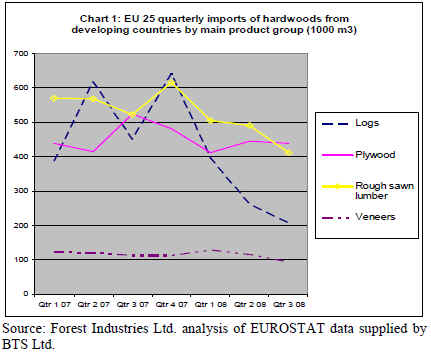
Chart 2 shows that the biggest decline in EU imports of
hardwood products from developing countries in the first
nine months of 2008 was recorded by France which has
seen a significant fall in the volume of log imports,
particularly from Africa. It also shows that Italian imports
have been on a downward trend at least since the start of
2007, a sign of longer term economic problems in that
country. Meanwhile imports into Spain and Portugal were
rising strongly throughout 2007, but fell dramatically from
the start of 2008 onwards with the bursting of Spain*s
housing bubble. Anecdotal reports indicate this trend
continued and intensified in the fourth quarter of 2008.
Spanish wood importers suggest that overall hardwood
sales in 2008 may be down as much as 30% to 40%
compared to the previous year. The German and Dutch
markets were characterized by a steady slide in imports
from around the third quarter of 2007 onwards.
Interestingly, both the UK and Belgian hardwood markets
were performing reasonably well until the end of
September 2008, but anecdotal reports indicate an abrupt
change of sentiment from October onwards.
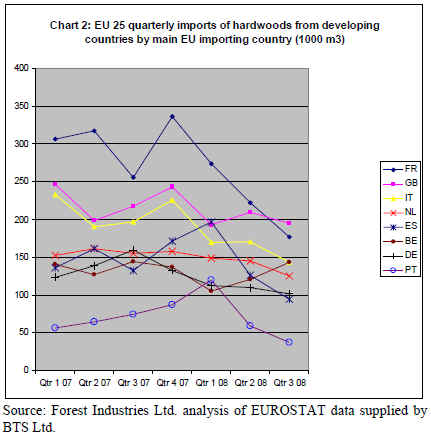
Chart 3, which shows data by major supplying country,
indicates that EU hardwood imports from Brazil have
declined very dramatically, with third quarter imports in
2008 being only around 50% of imports in 2007. Imports
of hardwood from China 每 which mainly consist of
plywood destined for the UK 每 have been extremely
volatile, which is not particularly unusual in the
commodity plywood sector. EU hardwood imports from
China in 2008 have been lower than in 2007, but on a
quarterly basis were tending to recover during the first 9
months of the year. This reflects particularly low levels of
EU plywood imports from China in the first quarter of
2008 owing to uncertainty over possible introduction of
anti-dumping duties on Chinese manufacturers.
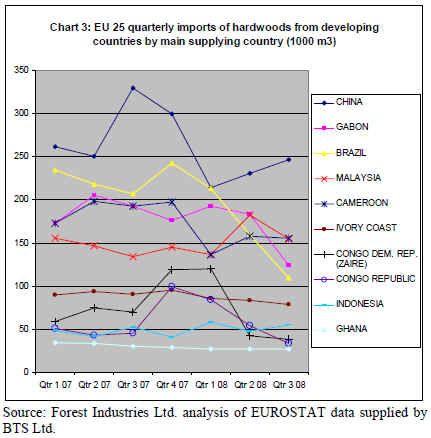
The fortunes of African countries supplying the EU have
varied widely over the last 12 months. Imports from
Gabon 每 much of which are destined for France 每 fell
rapidly in 2008. EU imports from the Democratic
Republic of Congo rose strongly at the end of 2008 and
into the first quarter of 2008, but then fell dramatically
thereafter. Imports from Cameroon, Cote d*Ivoire and
Ghana have generally remained more stable, showing only
a steady decline during the first three quarters of 2008.
Meanwhile EU hardwood imports from Malaysia actually
strengthened during 2008 and imports from Indonesia,
although still a shadow of their former size, also showed
some recovery. Both countries were benefiting from
mounting plywood supply problems amongst their major
competitors in China.
Putin signs resolution on Russian timber export duties
Prime Minister Vladimir Putin signed Resolution 982 on
24 December 2008, which set export fees at 25% from 1
January 2009 to 1 January 2010 on certain pine species
and birch with a diameter not less than 15 cm. The export
fees for oak, beech and ash are reported to be EUR100 for
per m³. The 80% export fees on major roundwood types is
effectively postponed as a result of the resolution (see also
TTMR 13:22).
German demand for African wood products worsen
In a recent report on German demand for African
hardwood, the trade journal EUWID notes that demand
worsened significantly in the closing weeks of 2008. Some
African exporters were cutting prices to German buyers in
an effort to obtain supply contracts but without much
success. EUWID noted that &indications of actual prices
are rather vague as many importers simply have not placed
any new orders in Africa*. As a result, EUWID reported
that price quotes for standard lumber items are ranging
very widely. For example, FOB prices for FAS air dried
sapele lumber in random lengths are quoted in the range
EUR400/m³ to EUR500/m³ (down from EUR500-600/m³
at the end of September 2008). Equivalent prices for sipo
are quoted at EUR500/m³ to EUR650/m³ (down from
EUR650-EUR700 at the end of September 2008). EUWID
note that prices quoted for logs by African shippers to
German importers seem to be more stable but low levels
of actual purchasing make any meaningful assessment of
real market prices difficult.
No sign of light in UK plywood market
&Desperation to clear stock heightens competition* - the
headline of the UK Timber Trade Journal*s most recent
report on the UK plywood market gives an idea of the
scale of the challenges currently facing the sector. Writing
in mid December, TTJ noted that &in many cases
customers* cheque books were locked away several weeks
ago and have not reappeared. It has become almost
impossible for plywood importers to quote a price that
would encourage a purchaser to buy ahead of the
Christmas period*. At that time, UK importers were offloading
stock as fast as possible, putting strong downward
pressure on landed stock prices. TTJ reported that offers of
Chinese plywood &at very low levels*, supported in part by
the Chinese government*s decision to raise tax rebates on
plywood and other panels from 5% to 9% in an effort to
support export sales, had yet to have any impact on UK
purchasing decisions. Some of the UK*s largest importers
of Chinese plywood are believed already to be sitting on
several month*s stock and some of those that have placed
forward orders have been requesting delays to shipment
and even attempting to renegotiate contracts. TTJ notes
that prices for Malaysian plywood on offer to UK buyers
have also weakened on the back of the generally negative
market sentiment.
European construction holds out for prospect of longterm
growth
Given that the European construction sector is estimated to
account directly for around 70% of all European
consumption of wood products, future activity in this
sector to a large extent holds the key to future market
demand. A comprehensive forecast of future trends was
one outcome of the EUROCONSTRUCT Conference
which brought together 180 experts in early December.
This suggests that, despite the short-term gloom, there are
reasons to be optimistic about medium and long-term
prospects.
According to EUROCONSTRUCT, the construction
market in Europe is worth nearly 1,650 billion (thousand
million) euros, a figure which exceeds the entire GDP of
Italy. While much of the news surrounding European
construction in recent times has focused on the rapid
deterioration of residential construction in several western
European markets 每 notably in Spain, the UK and Ireland
每 EUROCONSTRUCT highlight that this is only part of
the story.
EUROCONSTRUCT emphasize the huge variations in
construction sector activity that exist throughout Europe.
For example, Eastern European markets (Poland, Czech
Republic, Slovakia, Hungary) differ greatly from the
market of the Western countries. In the West, residential
covers nearly 50% of the market, while in the countries of
the East, civil engineering and non-residential construction
are more important. The average budget spent per capita in
construction in Western Europe is still three or four times
more than the spending made in the Eastern countries.
Nevertheless, according to the EUROCONSTRUCT
forecasts, Eastern Europe will be the focus for
construction sector growth in the short to medium-term.
EUROCONSTRUCT note that no European country will
be spared by the economic crisis, even in the construction
field. Construction output is falling or remains at best
positive in Western Europe for the 2008-2009 period.
Ireland and Spain are, in this respect, the countries most
affected by the crisis. These two countries excepted,
participants at the conference predicted growth of 0.2% for
2010 and nearly 1.5% in 2011.
In Eastern Europe, EUROCONSTRUCT forecast that
construction will continue to grow in 2009 but less
markedly than in previous years. Despite the global
economic crises, Poland is still going through a good
period thanks to work starting on large infrastructure
projects. What's more, from 2010, growth is expected to
be more sustained for all the Eastern countries.
EUROCONSTRUCT*s general analysis of the sector for
2009 shows that, until recently, it was above all residential
that was experiencing difficult times. Although nonresidential
escaped this negative trend for a while, it
appears that it is now caught in the storm. This trend will
also affect the civil engineering segment, which will see a
reduction in growth though most often without going into
the red. Again however, forecasts in this field are less
alarming for Eastern Europe.
The figures for renovation throughout Europe are expected
to follow a downward trend in 2009 but on a smaller scale
than the other segments of the sector. This is good news
for hardwood given that renovation projects often use a
relatively higher proportion of real hardwood products
compared to softwoods and other materials than new build
projects.
EUROCONSTRUCT are also optimistic about longer term
prospects, forecasting recovery in the sector from 2010
onwards. The rate of recovery will however vary widely
by construction segment. The first to get its head above
water should be civil engineering, closely followed by
renovation. On the other hand, no improvement in new
construction is expected until at least 2011.
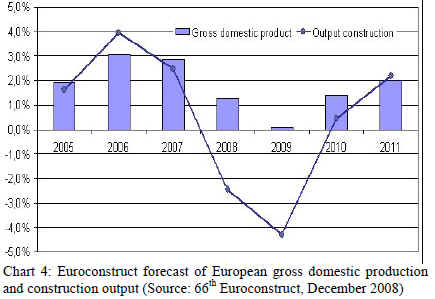
EUROCONSTRUCT also note that the economic crisis is
not the only challenge currently faced by the European
construction industry. Other key factors affecting the
sector will be a forecast rise in demand for single family
homes and a general ageing in the European population.
And overshadowing all this is the strong and intensifying
political focus on combating global warming which is
expected to have huge repercussions on all the
construction segments.
Speakers at the Conference were unanimous in the view
that sustainable construction is an opportunity waiting to
be seized. The issue of global warming highlights the need
for infrastructure developments that can better withstand
climate fluctuations, for superior energy performance, and
for wider use of materials that sequester carbon.
EUROCONSTRUCT point out that in order to meet EU
targets for reduced greenhouse gas emissions over the next
half century, a large proportion of Europe*s existing
housing stock will have to be either renovated or replaced
to ensure they meet much higher insulation levels.
The medium and long-term opportunities implied by the
EUROCONSTRUCT forecasts for increased consumption
of wood, which is the most energy efficient building
material available, are obvious.
More information about the economic situation and course
of European construction can be obtained from two reports
(&Summary Report* and the &Country Report*) published
by EUROCONSTRUCT. These can be ordered them from
the organizer of the EUROCONSTRUCT conference
(info@aquiec.be).
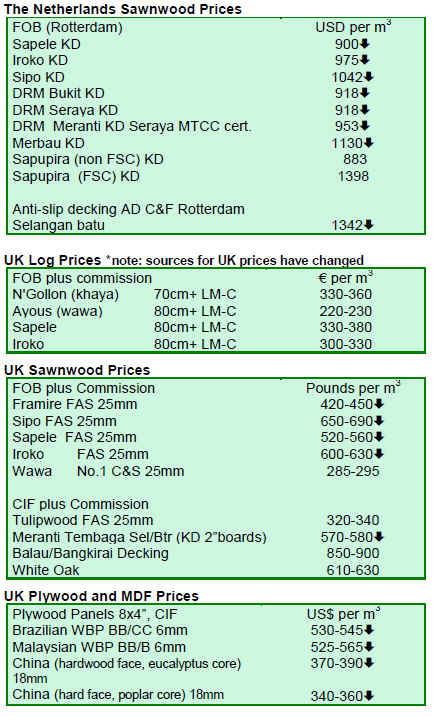
|